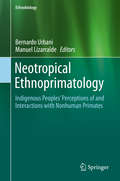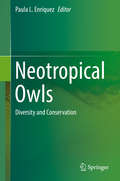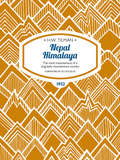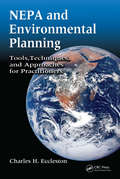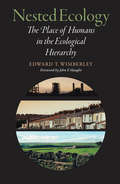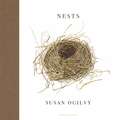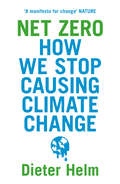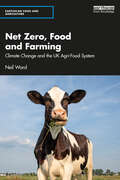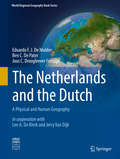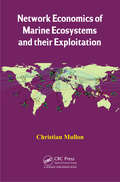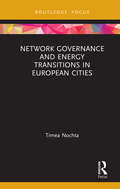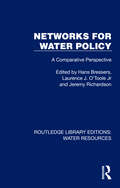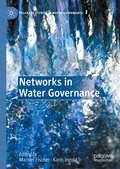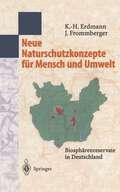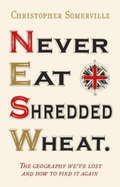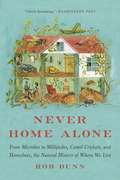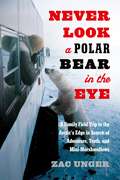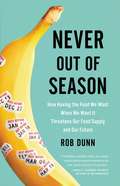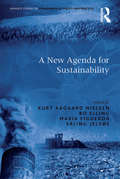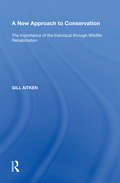- Table View
- List View
Neotropical Ethnoprimatology: Indigenous Peoples’ Perceptions of and Interactions with Nonhuman Primates (Ethnobiology)
by Bernardo Urbani Manuel LizarraldeEthnoprimatology is situated at the intersection between the biological and cultural subfields of anthropology. Research on the interface between human and nonhuman primates has been steadily increasing since 1997, when the term ethnoprimatology was first coined. Although there have been studies on human–nonhuman primate interactions in the tropical Americas, no single comprehensive volume has been published that integrates this information to fully understand it in this region. Eighteen novel chapters written by outstanding scholars with various backgrounds are included in this edited volume. They refer to the complex interconnections between different indigenous peoples with New World monkeys that sympatrically share their ancestral territories. Geographically, the range covers all of the Neotropics, from southern Mexico through northern Argentina. This work includes topics such as primates as prey and food, ethnozoology/ethnoecology, cosmology, narratives about monkeys, uses of primates, monkeys as pets, and ethnoclassification. Multiple views as well as diverse theoretical and methodological approaches are found within the pages. In sum, this is a compendium of ethnoprimatological research that will be prized by anthropologists, ethnobiologists, primatologists, conservationists, and zoologists alike.“This book… provides a historical benchmark for all subsequent research in ethnoprimatology in the Neotropics and beyond.” — Leslie E. Sponsel, University of Hawai´i at Mānoa.
Neotropical Owls: Diversity and Conservation
by Paula L. EnriquezThis book presents a comprehensive biological and ecological information about owls in the neotropic area. In addition the book covers topics such as threats and conservation strategies for these nocturnal birds of prey from 18 Neotropical countries. Owls are a good example of diversification processes and have developed evolutionary characteristics themselves. These species are found almost everywhere in the world but most of them are distributed in tropical areas and about a third of them live in the Neotropics. This biogeographic region has a high biodiversity and even share lineages of species from other continents because at some point all were part of Pangea. Although we still have much to know and understand about this diverse, scarcely studied and threatened group this work aims to be a precedent for future and further research on the subject.
Nepal Himalaya: The most mountainous of a singularly mountainous country. (H.W. Tilman: The Collected Edition)
by H.W. TilmanThroughout 1949 and 1950 H.W. ‘Bill’ Tilman mounted pioneering expeditions to Nepal and its Himalayan mountains, taking advantage of some of the first access to the country for Western travellers in the 20th century. Tilman and his party—including a certain Tenzing Norgay—trekked into the Kathmandu Valley and on to the Langtang region, where the highs and lows began.They first explored the Ganesh Himal, before moving on to the Jugal Himal and the following season embarking on an ambitious trip to Annapurna and Everest. Manaslu was their first objective, but left to ‘better men’, and Annapurna IV very nearly climbed instead but for bad weather which dogged the whole expedition. Needless to say, Tilman was leading some very lightweight expeditions into some seriously heavyweight mountains.After the Annapurna adventure Tilman headed to Everest with—among others—Dr Charles Houston. Approaching from the delights of Namche Bazaar, the party made progress up the flanks of Pumori to gaze as best they could into the Western Cwm, and at the South Col and South-East Ridge approach to the summit of Everest. His observations were both optimistic and pessimistic: ‘One cannot write off the south side as impossible until the approach from the head of the West Cwm to this remarkably airy col has been seen.’ But then of the West Cwm: ‘A trench overhung by these two tremendous walls might easily become a grave for any party which pitched its camp there.’Nepal Himalaya presents Tilman’s favourite sketches, encounters with endless yetis, trouble with the porters, his obsessive relationship with alcohol and issues with the food. And so Tilman departs Nepal for the last time proper with these retiring words: ‘If a man feels he is failing to achieve this stern standard he should perhaps withdraw from a field of such high endeavour as the Himalaya.’
NEPA and Environmental Planning: Tools, Techniques, and Approaches for Practitioners
by Charles H. Ecclestonthe most comprehensive book on NEPA and impact assessment to date.provides practical guidance for navigating the complexities of NEPA, environmental planning; readers are provided with a single guide describing modern tools, techniques, and approaches for streamlining project implementation. Dr. Lynton K. Caldwell,The Father of NEP
Nested Ecology: The Place of Humans in the Ecological Hierarchy
by Edward T. WimberleyNested Ecology provides a pragmatic and functional approach to realizing a sustainable environmental ethic. Edward T. Wimberley asserts that a practical ecological ethic must focus on human decision making within the context of larger social and environmental systems. Think of a set of mixing bowls, in which smaller bowls sit within larger ones. Wimberley sees the world in much the same way, with personal ecologies embedded in social ecologies that in turn are nested within natural ecologies. Wimberley urges a complete reconceptualization of the human place in the ecological hierarchy. Going beyond the physical realms in which people live and interact, he extends the concept of ecology to spirituality and the "ecology of the unknown." In doing so, Wimberley defines a new environmental philosophy and a new ecological ethic.
Nests
by Susan OgilvyAn exquisitely illustrated, one-of-a-kind celebration of the hidden beauty of nature and the ingenuity of birds Susan Ogilvy started painting bird nests almost by accident. One day, while tidying up her garden after a storm, she found a chaffinch nest - a strange, sodden lump on the grass under a fir tree. She carried it inside and placed it on a newspaper; over the next few hours, as the water drained out of it, the sodden lump blossomed into a mossy jewel. She was amazed, and dropped everything to make a painting of the nest at exact life size.This was the start of an obsession; Ogilvy has since painted more than fifty bird nests from life, each time marvelling at its ingenious construction. Every species of bird has its own vernacular, but sources its materials - most commonly twigs, roots, grasses, reeds, leaves, moss, lichen, hair, feathers and cobwebs, less usually, mattress stuffing and string - according to local availability. Ogilvy would, of course, never disturb nesting birds; instead she relies upon serendipity, which is why all her nests have either been abandoned after fulfilling their purpose, or displaced by strong winds.Although Nests showcases the specimens she has found near her homes in Somerset and on the Isle of Arran, its subject matter is by no means only British, since these same birds can be found all over Europe, Scandinavia and as far afield as Russia, Turkey and North Africa. This wondrous book is all the more special for its rarity. Few modern books exist specifically on the subject of bird nests; the most recent among the author's reference works was published in 1932. Exquisitely designed and packaged, Nests will be an essential addition to the libraries of all nature lovers.
Net Zero: How We Stop Causing Climate Change
by Dieter HelmWhat can we really do about the climate emergency? The inconvenient truth is that we are causing the climate crisis with our carbon intensive lifestyles and that fixing – or even just slowing – it will affect all of us. But it can be done.
Net Zero, Food and Farming: Climate Change and the UK Agri-Food System (Earthscan Food and Agriculture)
by Neil WardThis book examines the implications of the net zero transition for food and farming in the UK and how these can be managed to avoid catastrophic climate change in the crucial decades ahead. For the UK to meet its international obligations for reducing greenhouse gas emissions, nothing short of a revolution is required in our use of land, our farming practices and our diet. Taking a historical approach, the book examines the evolution of agriculture and the food system in the UK over the last century and discusses the implications of tackling climate change for food, farming and land use, setting the UK situation in an international context. The chapters analyse the key challenges for this transition, including dietary change and food waste, afforestation and energy crops, and low-emission farming practices. This historical perspective helps develop an understanding of how our food, farming and land use system has evolved to be the way that it is, and draws lessons for how the agri-food system could evolve further to support the transition to net zero and avoid catastrophic climate change. Written in a clear and accessible style, this book will be essential reading to students and scholars of food, agriculture and the environment, as well as policymakers and professionals involved climate change policy and the agriculture and food industry.
Net Zero, Food and Farming: Climate Change and the UK Agri-Food System (Earthscan Food and Agriculture)
by Neil WardThis book examines the implications of the net zero transition for food and farming in the UK and how these can be managed to avoid catastrophic climate change in the crucial decades ahead. For the UK to meet its international obligations for reducing greenhouse gas emissions, nothing short of a revolution is required in our use of land, our farming practices and our diet. Taking a historical approach, the book examines the evolution of agriculture and the food system in the UK over the last century and discusses the implications of tackling climate change for food, farming and land use, setting the UK situation in an international context. The chapters analyse the key challenges for this transition, including dietary change and food waste, afforestation and energy crops, and low-emission farming practices. This historical perspective helps develop an understanding of how our food, farming and land use system has evolved to be the way that it is, and draws lessons for how the agri-food system could evolve further to support the transition to net zero and avoid catastrophic climate change. Written in a clear and accessible style, this book will be essential reading to students and scholars of food, agriculture and the environment, as well as policymakers and professionals involved climate change policy and the agriculture and food industry.
The Netherlands and the Dutch: A Physical and Human Geography (World Regional Geography Book Series)
by Eduardo F. De Mulder Ben C. De Pater Joos C. Droogleever Fortuijn Len A. De Klerk Jerry Van DijkThis book presents a geographical survey of the Netherlands, reviewing recent and historic developments that made the nation. It is a relatively wealthy country and the Dutch belong to the happiest and healthiest on earth. But these qualities are not evenly spread over the country. The urban agglomeration of Randstad Holland in the west hosts most of the nation’s capital and young, well-educated people whereas older and less-educated people are concentrated in the peripheral areas in the north, east and south. Interactions between physical and human geographical aspects of the Netherlands are described quite extensively. Its position on one of Europe’s most prominent deltas, its abundance of energy resources and the course of history have all contributed to its present national position and international networks. But early and recent Dutch have also shaped this country. They reclaimed lakes and shallow seas, protected the lowlands against floods, re-allotted land parcels and designed and developed urban areas. Besides its focus on water-related topics, the book also covers social and cultural aspects. The book also discusses future challenges and offers scenarios for solutions. This is a book for those interested in a wide variety of recent aspects of the geography of the Netherlands described in a historical context. It appeals to students and researchers of many disciplines in geography, urban and landscape planning, water management, history and cultural studies.
Nettle Power: Forage, Feast & Nourish Yourself with This Remarkable Healing Plant
by Brigitte MarsA colorful, highly accessible guide to the healing and culinary uses of nettle, a protein-packed wild plant that is a favorite of foragers and herbalists.Nettle Power is a fascinating exploration of the many uses of nettle for food, medicine, and fiber. A plentiful wild plant with a long history of use by both European and Native American herbalists, nettle helps soothe skin conditions, strengthen bones, increase milk production in lactating mothers, restore the nervous system, purify the blood, and boost the immune system, among its many benefits. The plant's sting is easily neutralized by blanching and author Brigitte Mars shares a range of recipes for using the nutrient-dense green leaves as a tasty substitute for spinach or chard in salads, soups, and main dishes, along with healing recipes for teas, tinctures, juices, and elixirs. Colorful illustrations and curious facts and lore make this a highly browsable and useful handbook for foraging, herb, and natural health enthusiasts.
Network Economics of Marine Ecosystems and their Exploitation
by Christian MullonThis book addresses the question of the double exposure of marine ecosystems, i.e. to both global climate changes and economic globalization. This book contains a short, but self sufficient mathematical introduction, the formalization in the context of Network economics of global commodity chains, with both trophic and economic processes, and a ser
Network Governance and Energy Transitions in European Cities (Routledge Focus on Energy Studies)
by Timea NochtaThis book investigates and evaluates the opportunities and limitations of network governance in building local capacity for energy infrastructure governance. Presenting a comparative analysis of three city cases from across Europe- Birmingham, Frankfurt and Budapest- this book demonstrates how local factors shape the prospect of network governance to support low-carbon energy transitions. It maps out existing governance networks, highlighting the actors involved and their interactions with one another, and also discusses the role and embeddedness of networks in the urban governance of low-carbon energy. Drawing on case study evidence, Nochta develops a comparative analysis which discusses the intricate connections between network characteristics, context and impact. It highlights that organisational fragmentation; the complexity of the low-carbon energy problem and historical developments all influence network characteristics in terms of degree of integration and vertical (hierarchical) power relationships among network actors. Overall, the book concludes that understanding such links between context and networks is crucial when designing and implementing new governance models aimed at facilitating and governing low-carbon urban development. Low-Carbon Energy Transitions in European Cities will be of great interest to scholars of energy policy, urban governance and sustainability transitions.
Network Governance and Energy Transitions in European Cities (Routledge Focus on Energy Studies)
by Timea NochtaThis book investigates and evaluates the opportunities and limitations of network governance in building local capacity for energy infrastructure governance. Presenting a comparative analysis of three city cases from across Europe- Birmingham, Frankfurt and Budapest- this book demonstrates how local factors shape the prospect of network governance to support low-carbon energy transitions. It maps out existing governance networks, highlighting the actors involved and their interactions with one another, and also discusses the role and embeddedness of networks in the urban governance of low-carbon energy. Drawing on case study evidence, Nochta develops a comparative analysis which discusses the intricate connections between network characteristics, context and impact. It highlights that organisational fragmentation; the complexity of the low-carbon energy problem and historical developments all influence network characteristics in terms of degree of integration and vertical (hierarchical) power relationships among network actors. Overall, the book concludes that understanding such links between context and networks is crucial when designing and implementing new governance models aimed at facilitating and governing low-carbon urban development. Low-Carbon Energy Transitions in European Cities will be of great interest to scholars of energy policy, urban governance and sustainability transitions.
Networks for Water Policy: A Comparative Perspective (Routledge Library Editions: Water Resources)
by Hans Bressers Laurence J. O’Toole Jr Jeremy RichardsonNetwork models for analysing public policy have become widely used in recent years. This volume, originally published in 1995, assesses the network idea by applying a common perspective on network analysis to the constellations involved in water policy formation and implementation in England and Wales, Germany, Hungary, the Netherlands, the USA and at the level of the EU. Water policy – addressing basic human needs for the supply of adequate surface and groundwater as well as for the maintenance and improvement of water quality, is an increasingly salient subject. Each case covered in this volume treats the issues of water policy network composition and structure, and determinants of network characteristics, as well as documenting the influence of the networks on policy developments towards more network openness, emulation of business behaviour nd less domination by traditional professional groups such as engineers. Essays by the editors provide a common analytical perspective and offer both explicitly-comparative conclusions and evidence-based assessments of the strengths and limitations of the network perspective.
Networks for Water Policy: A Comparative Perspective (Routledge Library Editions: Water Resources)
Network models for analysing public policy have become widely used in recent years. This volume, originally published in 1995, assesses the network idea by applying a common perspective on network analysis to the constellations involved in water policy formation and implementation in England and Wales, Germany, Hungary, the Netherlands, the USA and at the level of the EU. Water policy – addressing basic human needs for the supply of adequate surface and groundwater as well as for the maintenance and improvement of water quality, is an increasingly salient subject. Each case covered in this volume treats the issues of water policy network composition and structure, and determinants of network characteristics, as well as documenting the influence of the networks on policy developments towards more network openness, emulation of business behaviour nd less domination by traditional professional groups such as engineers. Essays by the editors provide a common analytical perspective and offer both explicitly-comparative conclusions and evidence-based assessments of the strengths and limitations of the network perspective.
Networks in Water Governance (Palgrave Studies in Water Governance: Policy and Practice)
by Manuel Fischer Karin IngoldWith the consequences of climate change and biodiversity loss becoming more and more apparent, both the protection of water resources and water-related ecosystems as well as protection from water, that is flood protection policies, have become increasingly important. This book explores the latest applications of network analysis concepts and measures to the study and practice of water governance. Given the holistic complexity of water governance, it covers individual water governance aspects such as flood protection and fisheries, as well as overarching concepts like integrated water management and social-ecological interactions. The book provides an overview of current water governance issues, network analytic concepts as well as implications for practice. The main body of the text is made up of eight case studies by world-leading environmental governance scholars, each of which addresses one water-related challenge by applying a variety of network approaches. The first part of the book highlights network dispersion and fragmentation, the second focuses on how such fragmentation in networks can be overcome and the third deals with specific roles of actors in networks. This collection is a key resource for scholars and practitioners interested in water governance all over the world. It provides readers with an overview of the potential of network analytic concepts for research on complex governance problems.
Neue Naturschutzkonzepte für Mensch und Umwelt: Biosphärenreservate in Deutschland
by Karl-Heinz Erdmann Johanna FrommbergerDem Leser wird hier in allgemeinverständlicher Weise ein neues, auf internationaler Ebene von der UNESCO begleitetes und koordiniertes Naturschutzkonzept nähergebracht. In den 13 Biosphärenreservaten Deutschlands steht nicht der konservierende Naturschutz im Vordergrund, sondern vielmehr das Bemühen des wirtschaftenden Menschen, zu einem harmonischen Miteinander von Natur und Mensch zu gelangen. Die Autoren erläutern u. a. Auswahlkriterien, rechtliche und institutionelle Organisation, Finanzierung und räumliche Gliederung jeweils am Beispiel eines oder mehrerer bereits bestehender Biosphärenreservate. Zahlreiche Karten und Farbabbildungen tragen dabei zur Anschaulichkeit der Ausführungen bei.
Never Eat Shredded Wheat: The Geography We've Lost And How To Find It Again
by Christopher SomervilleBognor Regis...Aberystwyth...Glasgow...Can you place them on a map? Most people can't these days. What kind of countryside do you pass through on your way to the Cairngorms, or the Fens, or Northumberland? What's north of the Pennines? And what's it like when you get there? Most folk wouldn't have a clue. Increasing numbers of us don't have a basic geographical notion of these islands. Blame it on a decline in formal geography teaching, or Sat-Nav and other 'A to Z and nothing in between' devices that make us lazy -- we are becoming the best travelled and least well orientated Britons ever seen. Now Christopher Somerville, bestselling author of Coast and many other books of UK exploration, presents the basics of what belongs where, which counties border one another, and what lies beyond the Watford Gap. He reminds us of the watery bits, the lumpy bits and the flat bits, and gets to grips with the smaller islands surrounding Britain -- and much more. Never Eat Shredded Wheat is a reminder of all the fascinating British geography once learned at school - geography that brings our islands vividly to life - geography which we have forgotten, or never even knew.
Never Home Alone: From Microbes to Millipedes, Camel Crickets, and Honeybees, the Natural History of Where We Live
by Rob DunnDiscover the "fascinating" and surprising science of the creepers, crawlers, wrigglers, and runners that live in our homes (The Washington Post) -- and learn why they're essential to our everyday lives.However domesticated our houses appear, they are wild beyond imagination. Look down in the basement, up in the attic, under the floorboards, and even in the showerhead, and you'll find life everywhere. Biologist Rob Dunn and his team have done it in homes worldwide, and they found nearly 200,000 species!In Never Home Alone, Dunn introduces us to these tiny tenants and shows us how -- in almost every case -- they make our lives better, and explains why trying to eradicate the bad ones just makes our lives worse. No one who reads this engrossing, revelatory, and just plain fun book will look at their home, or the life in it, in the same way again.A New York Times Book Review's "Editor's Choice""Excellent." -- Wall Street Journal"You'll love Never Home Alone." -- Bustle
Never Look a Polar Bear in the Eye: A Family Field Trip to the Arctic's Edge in Search of Adventure, Truth, and Mini-Marshmallows
by Zac Unger&“I like to go out for walks, but it&’s a little awkward to push the baby stroller and carry a shotgun at the same time.&”—housewife from Churchill, Manitoba Yes, welcome to Churchill, Manitoba. Year-round human population: 943. Yet despite the isolation and the searing cold here at the arctic&’s edge, visitors from around the globe flock to the town every fall, driven by a single purpose: to see polar bears in the wild.Churchill is &“The Polar Bear Capital of the World,&” and for one unforgettable &“bear season,&” Zac Unger, his wife, and his three children moved from Oakland, California, to make it their temporary home. But they soon discovered that it&’s really the polar bears who are at home in Churchill, roaming past the coffee shop on the main drag, peering into garbage cans, languorously scratching their backs against fence posts and front doorways. Where kids in other towns receive admonitions about talking to strangers, Churchill schoolchildren get &“Let&’s All Be Bear Aware&” booklets to bring home. (Lesson number 8: Never explore bad-smelling areas.)Zac Unger takes readers on a spirited and often wildly funny journey to a place as unique as it is remote, a place where natives, tourists, scientists, conservationists, and the most ferocious predators on the planet converge. In the process he becomes embroiled in the controversy surrounding &“polar bear science&”—and finds out that some of what we&’ve been led to believe about the bears&’ imminent extinction may not be quite the case. But mostly what he learns is about human behavior in extreme situations . . . and also why you should never even think of looking a polar bear in the eye.
Never Out of Season: How Having the Food We Want When We Want It Threatens Our Food Supply and Our Future
by Rob DunnThe bananas we eat today aren't your parents' bananas: We eat a recognizable, consistent breakfast fruit that was standardized in the 1960s from dozens into one basic banana. But because of that, the banana we love is dangerously susceptible to a pathogen that might wipe them out. That's the story of our food today: Modern science has brought us produce in perpetual abundance once-rare fruits are seemingly never out of season, and we breed and clone the hardiest, best-tasting varieties of the crops we rely on most. As a result, a smaller proportion of people on earth go hungry today than at any other moment in the last thousand years, and the streamlining of our food supply guarantees that the food we buy, from bananas to coffee to wheat, tastes the same every single time. Our corporate food system has nearly perfected the process of turning sunlight, water and nutrients into food. But our crops themselves remain susceptible to the nature's fury. And nature always wins. Authoritative, urgent, and filled with fascinating heroes and villains from around the world, Never Out of Season is the story of the crops we depend on most and the scientists racing to preserve the diversity of life, in order to save our food supply, and us.
A New Agenda for Sustainability (Routledge Studies in Environmental Policy and Practice)
by Bo Elling Erling JelsøeTwo decades after the Brundtland Commission's Report "Our Common Future" adopted the concept of 'sustainable development', this book provides a renewal of the concept exploring the potential for new practices and fields for those involved in sustainability activity. The book addresses a number of themes concerning firstly, the provision of a "next generation perspective", which was a central, and still unresolved, notion of the original Brundtland definition and, secondly the provision of new milestones for policy and research that can expand the discussion on this second generation concept on sustainability. The material dealt with in the book offers a wide variety of perspectives on sustainability and reflects the importance of interdisciplinary and transdiciplinary work in the field. Suggesting targets for future analytical and political efforts in achieving global sustainability, this book offers new analytical opportunities for holistic politics and research at a general and sector level.
A New Agenda for Sustainability (Routledge Studies in Environmental Policy and Practice)
by Bo Elling Erling JelsøeTwo decades after the Brundtland Commission's Report "Our Common Future" adopted the concept of 'sustainable development', this book provides a renewal of the concept exploring the potential for new practices and fields for those involved in sustainability activity. The book addresses a number of themes concerning firstly, the provision of a "next generation perspective", which was a central, and still unresolved, notion of the original Brundtland definition and, secondly the provision of new milestones for policy and research that can expand the discussion on this second generation concept on sustainability. The material dealt with in the book offers a wide variety of perspectives on sustainability and reflects the importance of interdisciplinary and transdiciplinary work in the field. Suggesting targets for future analytical and political efforts in achieving global sustainability, this book offers new analytical opportunities for holistic politics and research at a general and sector level.
A New Approach to Conservation: The Importance of the Individual through Wildlife Rehabilitation
by Gill AitkenConservationists assume a set of underlying values which guide their decision-making and action. The safeguarding or promotion of biodiversity, it is believed, is the means by which nature is best protected. This book examines - and challenges - these general conservation assumptions. While reinforcing the need to halt extinction and value biodiversity, it shows that biodiversity needs to be more clearly understood, perhaps being replaced by the notion of 'wildness'. It examines how biodiversity is a holistic term, and how individual species need to be assessed and their own contribution to 'wildness' has to be recognized. The book proposes a new way of conservation - one which makes more room for neglected, rather than endangered or rare species. It also asserts that 'wildness' is not incompatible with certain kinds of human intervention.
